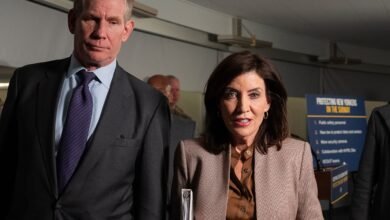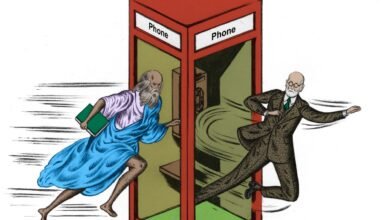What Could Citizens’ Assemblies Do for American Politics?

Last July, an unusual letter arrived at Kathryn Kundmueller’s mobile home, in central Oregon. It invited her to enter a lottery that would select thirty residents of Deschutes County to deliberate for five days on youth homelessness—a visible and contentious issue in an area where the population and cost of living have spiked in recent years. Those chosen would be paid for their time—almost five hundred dollars—and asked to develop specific policy recommendations.
Kundmueller was being invited to join what is known as a citizens’ assembly. These gatherings do what most democracies only pretend to: trust normal people to make decisions on difficult policy questions. Many citizens’ assemblies follow a basic template. They impanel a random but representative cross-section of a population, give them high-quality information on a topic, and ask them to work together to reach a decision. In Europe, such groups have helped spur reform of the Irish constitution in order to legalize abortion, guided an Austrian pharmaceutical heiress on how to give away her wealth, and become a regular part of government in Paris and Belgium. Though still rare in America, the model reflects the striking idea that fundamental problems of politics—polarization, apathy, manipulation by special interests—can be transformed through radically direct democracy.
Kundmueller, who is generally frustrated by politics, was intrigued by the letter. She liked the prospect of helping to shape local policy, and the topic of housing insecurity had a particular resonance for her. As a teen-ager, following a falling-out with her father, she spent months bouncing between friends’ couches in Vermont. When she moved across the country to San Jose, after college, she lived in her car for a time while she searched for a stable job. She worked in finance but became disillusioned; now in her early forties, she ran a small housecleaning business. She still thought about living in a van and renting out her mobile home to save money.
From an initial mailing to twelve thousand seven hundred households in Deschutes County, about a hundred and twenty people responded. The assembly’s organizers—a group of nonprofits with support from local elected officials and philanthropic funding—wanted selected delegates to mirror the county’s demographics along many axes, including age, gender, housing status, ethnicity, political affiliation, and education. Using survey results from the respondents, the Portland-based organization Healthy Democracy deployed a software program to create numerous combinations of delegates that would reflect the region in microcosm. When one of those groups was chosen at random, through a lottery-style system, Kundmueller was in it.
The assembly lasted five full days, spread across two weekends a few weeks apart. The members of the cohort, who ranged in age from their teens to their eighties, included a retired pipe fitter, an I.T. specialist, a restaurant manager, a worker at a local bullet manufacturer, and several small-business owners. Some of the delegates were struggling to pay rent in cramped apartments; others owned spacious homes with many spare rooms. About fifty per cent were politically unaffiliated, with the other half split evenly between Democrats and Republicans.
They met in the airy wood-panelled atrium of a new building on the Oregon State University-Cascades campus, in the county seat of Bend, and spent the first weekend learning about youth homelessness and about one another, with icebreakers, small-group discussions, and presentations from experts. “It had an awkward vibe in the room to me, in a really good way, sort of that first-class-of-college kind of feel,” a member of a regional government council who observed the first weekend told me.
Awkward but civil conversation was an improvement over recent political discourse about homelessness in Deschutes County. One Bend city-council member recalled a public meeting at which someone compared homeless people to raccoons, saying that if they’re fed, they will stay in the area and make more raccoons. Advocates for homeless people could be extreme, too; another local elected official described being likened to a Nazi for suggesting a need to regulate encampments.
During the first weekend, the assembly members generated questions that they wanted answered in the second session. The organizers then convened panels made up of nonprofit service providers, government employees, and community advocates to address the delegates. Some questions were very broad, such as “How can we disrupt the cycle of generational poverty?” Others were highly targeted: “How much money is spent sweeping the homeless encampments?” and “Is there more funding or resources to build more tiny homes?”
In an age of high political polarization and dysfunction, a diverse group of citizens calmly studying and discussing a nuanced issue presents a surprisingly functional image of politics. “It was like Congress without the showboating,” Elizabeth Marino, an associate professor of anthropology at O.S.U.-Cascades whose research explores divisive conversations, said of the first weekend. Marino, alongside a group of researchers from M.I.T., was interested in observing the assembly to understand how people navigate charged conversations. Marino’s research team has found that when they shift the moral frames used to discuss polarizing topics, greater consensus becomes possible. In one study, the researchers discovered that when climate change was framed in terms of patriotism, personal responsibility, and the purity of America’s environment, conservatives were more likely to say that it was caused by humans than when the topic was discussed with an emphasis on values like justice or fairness, which typically appeal more to liberals. The team found a similar result when a suicide-prevention message aimed at firearm owners invoked tradition and responsibility. These were controlled studies; whether anything similar would happen spontaneously in Bend was an open question.
On a cool Friday morning in October, the delegates talked over coffee and fruit in the light-filled atrium as they waited for the final three days of the assembly to begin. The aesthetic in the room was split between elk-hunting cabin and trendy coffee shop; some people wore jeans, work boots, or cowboy hats, while others were in leggings, puffy jackets, and hoodies. Bend reflects a similar mix: the city, which has a population of roughly a hundred thousand, is a former logging town now home to craft breweries, upscale boutiques, and tech companies.
As the delegates took their seats at a large U-shaped table, they chatted amiably. After the first weekend, they now knew who played Scrabble, who owned alpacas, who did upholstery work. The mood was more neighborhood-association potluck than city-council meeting.
On a bank of windows was a cloud of yellow sticky notes on which delegates had written points that they wanted the entire group to consider. These ranged from the factual (“500 homeless kids in central Oregon”) to policy pitches (“Cash direct transfers has shown life altering changes for youth in the homeless system”) to an aphorism attributed to the conservative economist Thomas Sowell (“There are no solutions, only trade-offs”).
During the morning session, a delegate named Benjamin, a bearded man in a blue-and-white plaid shirt, tapped the microphone on the table in front of his seat and began to speak. Based on the information presented, he said, it seemed safe to assume that it was not possible to increase the supply of housing fast enough to drive down prices. He wondered instead if there was a way to decrease demand from “buyers from outside the area” who had “disproportionate purchasing power.”
The three panelists—all housing-policy experts and staffers in city or county government—did not offer any concrete ways to do this. “It’s probably a bigger philosophical discussion,” Erik Kropp, the deputy county administrator for Deschutes, said. “I’m not sure how you limit the purchaser in terms of where they’re coming from.” When a second panelist mentioned a policy in Portland that used property-tax revenue to fund affordable housing, Benjamin, reading from his laptop, cited various places that tax buyers from outside of the region: “I have a list right here,” he said. Kundmueller, a few seats away, nodded as he spoke and jotted something down on her notepad. “Is that something that you consider to be politically feasible?” Benjamin asked the members of the panel. They didn’t know; one suggested it was a question for elected officials, not staff.
Benjamin’s idea could be seen as a wealth tax, but this was not how he presented it. He instead made an implicit appeal to defend people within the area from outsiders driving up prices. “That struck me,” Marino said later. “That felt like a novel path forward. That’s something you don’t get very often when you’re listening to a debate on the floor, right?”
During a snack break, I approached Benjamin, who was holding forth to a small group of delegates about the unreliability of the media. The rumors about immigrants eating pets in Springfield, Ohio, were grounded in truth, he claimed—he was from there, so he should know. He was happy to talk with me about his life and his political views, which he described as “somewhere in the vicinity of anarchism, agorism, and libertarianism.” But he felt that these labels were misleading. “What libertarian have you heard suggest hiking up taxes?”





